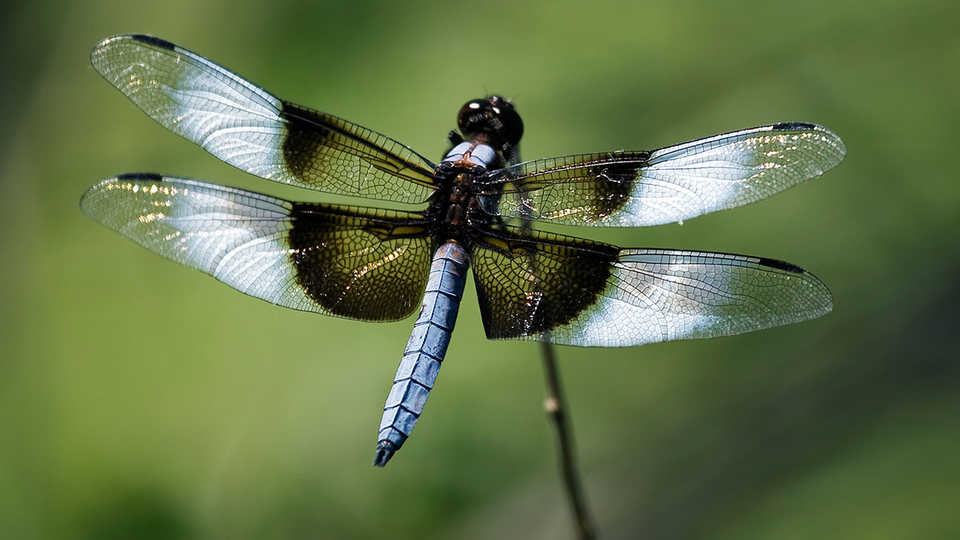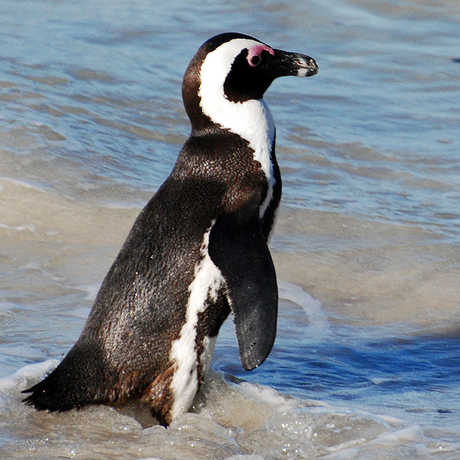
© John Wright
Ever played the card game Go Fish? If you know the rules, you can easily learn how insects undergo the stages of metamorphosis to become an adult.
By playing a simple card game based on the stages of metamorphosis, students will:
- Learn how insects change in form as they grow.
- Consider the advantages of undergoing this metamorphosis.
- Print out Go Bug! cards. If possible, print 2-sided in color.
- Cut out Go Bug! cards along dotted lines. Shuffle and stack each deck.
- How do insects grow? Ask students what they know about the growth and development of insects. Many will already be familiar with, for instance, the life cycle of butterflies.
- Define metamorphosis, explaining the different stages that a given insect will go through as it develops. Aside from insects, are their other animals that undergo metamorphosis? Yes! Frogs, etc. (see Background for Educators)
- Split class into groups (2.5 min.) Split class into groups of three to six students. Arrange classroom such that each group of students may sit facing one another other, with a flat surface in front of each, whether a desk or a table.
-
Explain rules of Go Bug! (5 min.) Explain how to play Go Bug! following the rules described below. This activity is a variation on the common card game entitled “Go Fish!”
-
Oversee game play (30 min): Assist and direct groups with game play as needed. All groups should play one complete round. Have students play as many games as they have time for. Consider mixing up the groups if possible.
- Goal: To collect as many complete sets of insect cards.
- Setup: Five cards are dealt to each player. All remaining cards are placed face down in a draw pile.
- Gameplay:
- Randomly choose a player to go first.
- On your turn, ask a player for a specific type of insect out of the cards currently held in your hand. For example, if you’d like to add to your beetle cards, ask: "Katy, do you have any beetles?" You must already hold at least one card of the requested insect.
- If the player you ask has any cards of the requested insect, she must give all of her cards of that insect to you. In the example, Katy would have to give you all of her beetle cards.
- If you successfully receive one or more cards from the player you ask, you get another turn. You may ask any player for any insect you already hold, including the same type you just asked for. Your goal is to collect all of the stages for that insect.
- When you collect a complete set of three or four insect cards (depending on whether that insect undergoes complete or incomplete metamorphosis), immediately show the set to the other players and place the three or four cards face up in front of yourself. Place them in order from egg to adult.
- Continue asking for cards until the person you ask has no matching insects. Then they say, "Go Bug!" You then draw the top card from the draw pile.
- If you happen to draw a card of the insect you asked for, show it to the other players and you get another turn. However, if you draw a card that's not the type you asked for, just add it to your hand. It becomes the next player's turn.
- NOTE: The "next player" is always to the right of the student who just played.
- Parasite Cards:
- If you draw a parasite card, you may use this card to infest another player’s completed set of insect cards in order to add some cards to your collection. Note that parasite cards are specific to different insect stages; for example, some parasites can attack only larvae, and others can attack only nymphs. At the beginning of your turn, rather than asking for insect cards, you may choose to play your parasite on top of another player’s displayed card. You can then collect the stage specified on the parasite card, plus whatever stage(s) follow it. For example, if you play a Larval Host Parasite, then you will collect another player’s larva, pupa and adult of whatever host set you choose.
- NOTE: even though the host set of cards you collect will be incomplete, it will still be placed face up in front of you and these cards will be counted at the end of the game.
- Winning:
- Go Bug! continues until all the cards have been played. If a player runs out of cards before the others, they must still collect from the draw pile and give up cards when asked. Once the draw pile is depleted, game play continues without collecting a card each turn.
- In order to win, you must have the most cards laid in front of you. Often this means having the most sets of insect cards, but because sets may be three or four cards, and because you may have collected cards from using a parasite, it is the total number of displayed cards that wins the game.
On a white-board, or similar display, make a table to compare insects undergoing complete and incomplete metamorphosis. Call on students to tell you which insects fall into either category.
Ask the following questions:
- Which insects undergo incomplete metamorphosis? Complete?
- In the game, was it better to collect insects with complete or incomplete metamorphosis? Why?
- Can you think of any advantages to going through either type of metamorphosis?
- In the game, was it better to have a parasite with a larval host or an adult host? What would the advantages of each type be in real life?
Live Observation
- Plenty of insects are readily kept in captivity. Many a class has watched a caterpillar pupate and change into a butterfly, all within the confines of a glass jar. Other good insects to watch include: meal worms (complete metamorphosis), ladybugs (complete) and crickets (incomplete). All-inclusive kits may be ordered from scientific supply companies. The advantage of catching your own insects is the opportunity to observe the insect in its native environment first upon capture and second upon release.
Research Project
- As an in-class or homework assignment, have students research specific insects that undergo either complete or incomplete metamorphosis. Have students present a report on their insect that includes written descriptions along with pictures of the distinct life stages of their insect. Other important things for them to note might include:
- their insect's habitat
- their insect's range
- their food sources
- other insects they are related to
adult: the final, breeding stage of an insect’s life cycle, typically involving the growth of wings.
bug: true bugs are an order of insects called Hemitera, which includes 50,000 – 80,000 species and is comprised of cicadas, aphids, leafhoppers, “stink bugs,” water striders and others.
egg: the unborn stage of an insect.
host: the organism inside which a parasite grows and feeds.
larva (plural: larvae, pronounced LAHR-vee): the immature stage of an insect with complete metamorphosis, primarily involving voracious feeding and rapid growth. Larvae look very different from the adult insects they will become.
metamorphosis: the change of an insect (or other animal) from one form into another as it progresses to adulthood.
molt: the shedding of an insect’s outer skeleton as it grows too large for it.
nymph [nimf]: the immature stage of an insect with incomplete metamorphosis, primarily involving voracious feeding and rapid growth. Nymphs resemble the adult insects they will become through a process of growth and molting.
parasite: an organism that lives in (or on) a host organism and obtains nourishment from the host without benefiting or killing it.
pupa: the inactive stage between larva and adult, when no feeding occurs.
Insect Life Cycles
In biology, a life cycle refers to the period between an organism’s birth and its death, typically including reproduction. For many animals, including humans, a life cycle consists of the physical growth and maturation of a single body form. In other words, a baby is essentially a miniature version of an adult. When we compare this type of development with that of insects, or say, frogs, we note these later organisms progress through multiple body forms instead of a single form. Think of a butterfly. Emerging from an egg, is a caterpillar. That caterpillar grows and grows until one day it forms a cocoon around itself. Weeks later, a butterfly emerges from the cocoon bearing very little resemblance to the creature that created it. And yet, these two remarkably different forms are the very same animal.
This transformation from one form into another is called metamorphosis. There are three basic kinds of metamorphosis in insects. Some types of insects undergo a three-phase life cycle (egg-nymph-adult) called incomplete metamorphosis. Other insects have a four-phase cycle (egg-larva-pupa-adult) called complete metamorphosis. Some insects go through no metamorphosis at all, but this type of development is very rare and won’t be discussed in this activity. Essentially, these “ametabolous” insects hatch from their eggs looking like tiny versions of adults.
Metamorphosis in Other Animals
Insects aren’t the only animals that undergo metamorphosis. Most students are familiar with the development of frogs (egg-tadpole-pollywog-adult), but countless lesser-known examples of metamorphosis may be found in marine invertebrates including mollusks, crustaceans, cnidarians, echinoderms and tunicates. Even fish such as salmon, flounder and lampreys undergo a form of metamorphosis. In all these cases, changes in body forms typically coincide with a change in habitat and behavior.
Incomplete Metamorphosis
Incomplete metamorphosis is a term used to describe the mode of development of insects that pass through three distinct stages: the egg, the nymph, and the adult stage, or imago. Only 10 - 15% of the insects on Earth undergo incomplete metamorphosis. These insects go through gradual changes in size without a pupal stage (see Complete Metamorphosis).
These insects start as eggs, which are sometimes so small you cannot see them. When the egg hatches, a nymph comes out. Most of the time, the nymph looks similar to the adult, but smaller, with different coloration, and lacking wings and sexual organs. The nymph grows through stages called instars, shedding its 'skin' at each stage. Finally, it changes into an imago, the sexually mature adult with wings.
Aquatic insect nymphs, such as the mayfly illustrated above, usually have gills and look very different from the adults they will turn into.
Insect Orders with Incomplete Metamorphosis:
- Hemiptera - scale insects, aphids, whitefly, cicadas, leafhoppers and true bugs
- Orthoptera - grasshoppers and crickets
- Mantodea - praying mantises
- Blattaria - cockroaches
- Dermaptera - earwigs
- Odonata - dragonflies and damselflies
- Phasmatodea - stick insects
- Isoptera - termites
- Phthiraptera - sucking lice
- Ephemeroptera - mayflies
Complete Metamorphosis
Complete metamorphosis is a term used to describe the mode of development of insects that pass through four distinct stages: the egg, the larva, the pupa and the adult stage, or imago.
These insects also start as eggs. When the egg hatches, a larva comes out. The larva often resembles a worm and will feed voraciously so that it can quickly grow bigger. When the larva has reached its maximum size, it changes into a pupa. The pupa usually cannot move or eat. During the pupal stage, the larva changes into an adult that will look very different from the larva, typically inside a protective casing, such as a chrysalis, as in butterflies and moths. While inside the pupa, the insect will excrete digestive juices to destroy much of the larva's body, leaving a few cells intact. The remaining cells will begin the growth of the adult, using the nutrients from the broken down larva. The final, adult stage includes a fully developed insect with wings and reproductive organs.
Insect Orders with Complete Metamorphosis:
- Coleoptera - beetles
- Diptera - flies
- Hymenoptera - ants, bees, hornets and wasps
- Lepidoptera - butterflies and moths
- Mecoptera - scorpionflies
- Megaloptera - alderflies, dobsonflies and fishflies
- Neuroptera – lacewings and antlions
- Raphidioptera - snakeflies
- Siphonaptera - fleas
- Strepsiptera - twisted-winged parasites
- Trichoptera - caddisflies
Advantages of Complete Metamorphosis
There are an unbelievable number of insects out there. They occupy every niche on land known to man. This means that competition between and within species is often very high. Thus, the greater the difference in habits and habitats a species utilizes, the greater its advantage for survival and reproduction. For this reason, insects with complete metamorphosis, i.e. two radically different, active forms – larva and adult, have an advantage over insects with incomplete metamorphosis.
With complete metamorphosis, there is a tidy division of labor. The primary job of the larvae is to eat and grow. Adults on the other hand, are responsible for mating and the production of offspring.
Consider, if the adults of a certain species of insect fed on the same food as their larval forms, the larvae may deplete that food source before the adults have a chance to feed. So diversification of feeding habits can be a huge benefit to animals like insects whose food sources might be seasonally fleeting or simply scarce.
Diversification of physiology can also pose an advantage when it comes to predation. For example, if most of the winged adult mosquitoes get eaten up by a swarm of dragonflies, the aquatic mosquito larvae remain unharmed, safe at least from dragonfly adults.
Parasites
Nearly all insects are attacked by one or more insect parasites. These parasites are predominantly solitary wasps and a group of flies called Tachinids. These insects lay their eggs inside the bodies of an insect host. When the egg hatches, the larvae feeds on the host from the inside out! The larvae may continue to grow and even metamorphose within the host. In the end, the parasite kills the host before crawling out of it to go mate with other members of its species.
While some parasites target adult insects, others seek the eggs, larvae or pupae of host species. Often, parasites have very specific hosts. One species of parasitic wasp may have a single host species. Insect parasites can be very beneficial in the control of agricultural pest insects.
Grade Two
Life Sciences
- 2a. Students know that organisms reproduce offspring of their own kind and that the offspring resemble their parents and one another.
- 2b. Students know the sequential stages of life cycles are different for different animals, such as butterflies, frogs, and mice.


